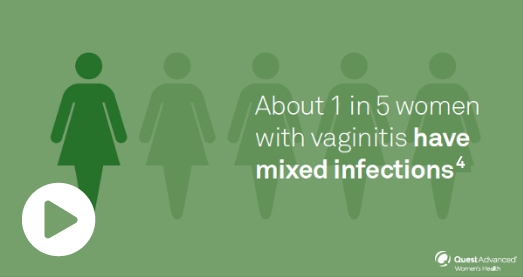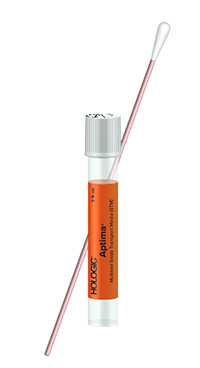Improved technology for more accurate diagnoses of vaginitis
Nucleic acid amplification test (NAAT) helps you identify the specific cause for more effective treatment
Vaginitis is one of the most common reasons women visit a healthcare provider,1 and 90% of these infections are caused by either bacteria (bacterial vaginosis (BV), yeast (Candida vaginitis (CV), or the parasite Trichomonas vaginalis (TV)2).
Identifying these vaginal infections is important for selecting treatment, and nonspecific and overlapping symptoms can make diagnosis a challenge. Taking a medical history, examination, and laboratory testing using NAAT technology gives you the ability to make a definitive diagnosis.


Better diagnostics with NAAT testing
Our understanding of vaginitis—as well as molecular technology—has vastly improved in the last 30 years, and newer, FDA-cleared molecular testing is now available. Based on this, we recommend SureSwab® Advanced, which uses NAAT and has shown to have greater sensitivity compared to the DNA probe.3
SureSwab Advanced can help you to obtain a definitive diagnosis of the 3 most common infectious causes of vaginitis, with just 1 vaginal swab and results in only 1-2 days.

Comparing SureSwab Advanced vaginitis
NAAT testing to DNA probe
for the 3 most common causes of vaginitis
SureSwab® Advanced
The Aptima® BV assay uses an algorithm to report a qualitative result for BV based on detection of the following organisms:
- Lactobacillus spp
- Gardnerella vaginalis
- Atopobium vaginae

Accurate results
with high sensitivity (95%-97%)
and specificity
(86%-90%)5
DNA probe
False positives on the order of
23%-32%
as a result of DNA probe only targeting:
• Gardnerella
vaginalis6,7

The American College of Obstetrics and Gynecology (ACOG) has stated that, “… because a single sentinel organism has not been found that accurately identifies patients with bacterial vaginosis, the diagnostic utility of a test that identifies only a single organism (eg, G vaginalis) ...is not currently supported.”2
SureSwab® Advanced
Aptima CV assay qualitatively reports Candida species group (C albicans, C tropicalis, C parapsilosis, and C dubliniensis), and Candida glabrata5

Accurate results
with high sensitivity (93%-98%)
and specificity (83%-92%)5
DNA probe
NO separate callout for C glabrata4

Low sensitivity
when compared to diagnostic assays featuring nucleic acid amplification technologies (NAAT)6
SureSwab® Advanced

Aptima TV Assay has high sensitivity
and specificity (95%-99%), ensuring the provider
and patient always receive an accurate
result.7

CDC and ACOG recommend NAATs
to detect TV4,8
DNA probe

Low sensitivity
means TV is often missed or undercalled
leading to false negatives6
NAAT testing



Someone from Quest Diagnostics will be in touch.

Aptima Multi-Test Collection Kit Supply # A03
SURESWAB ADVANCED TEST CODES
INDICATED TESTS
CPT CODES
COLLECTION DEVICE FOR SURESWAB
SURESWAB ADVANCED TEST CODES
10016
SureSwab Advanced Bacterial
Vaginosis (BV), TMA
INDICATED TESTS
Bacterial vaginosis
(Lactobacillus spp,
G vaginalis, A
vaginae)
CPT CODES
81513
SURESWAB ADVANCED TEST CODES
10121
SureSwab Advanced
Candida Vaginitis (CV), TMA
INDICATED TESTS
Candida vaginitis
- Candida species (C
albicans,
C tropicalis, C parapsilosis,
and C dubliniensis) - Candida Glabrata
CPT CODES
87481*2
SURESWAB ADVANCED TEST CODES
10029
SureSwab Advanced
Candida Vaginitis
(CV)/Trichomonas
vaginalis
(TV), TMA
INDICATED TESTS
Candida vaginitis
Trichomonas vaginalis
CPT CODES
87481*2
SURESWAB ADVANCED TEST CODES
10123
SureSwab Advanced
Bacterial Vaginosis (BV),
CT/NG, TMA
INDICATED TESTS
Bacterial vaginosis
Chlamydia
Gonorrhea
CPT CODES
81513
87491
87591
SURESWAB ADVANCED TEST CODES
10119
SureSwab Advanced
Vaginitis, TMA
INDICATED TESTS
Bacterial vaginosis
Candida vaginitis
Trichomonas vaginalis
CPT CODES
81513
87481*2
87661
SURESWAB ADVANCED TEST CODES
10120
SureSwab Advanced
Vaginitis Plus, TMA
INDICATED TESTS
Bacterial vaginosis
Candida vaginitis
Trichomonas
vaginalis
Chlamydia
Gonorrhea
CPT CODES
81513
87481*2
87661
87491
87591

Aptima Multi-Test Collection Kit Supply # A03
SureSwab®, Trichomonas vaginalis RNA, Qualitative, TMA (test code 19550); Chlamydia trachomatis RNA, TMA, Urogenital (test code 11361); Neisseria gonorrhoeae RNA, TMA, Urogenital (test code 11362); Chlamydia/Neisseria gonorrhoeae RNA, TMA, Urogenital (test code 11363)
To learn more about the benefits of SureSwab Advanced visit QuestVaginitis.com
References:
- Hildebrand JP, Kansagor AT. Vaginitis. Internet. StatPearls Publishing. Published January 2022. Updated November 14, 2022. Accessed December 5, 2022. https://www.ncbi.nlm.nih.gov/books/NBK470302/
- ACOG. Vaginitis in nonpregnant patients. practice bulletin No. 215. American College of Obstetricians and Gynecologists. Obstet Gynecol. 2020;135(1):e1-17. doi:10.1097/AOG.0000000000003604
- Fredricks DN, Fiedler TL, Thomas KK, et al. Targeted PCR for detection of vaginal bacteria associated with bacterial vaginosis. J Clin Microbiol. 2007;45(10):3270-3276. doi:10.1128/JCM.01272-07
- Cartwright CP, Lembke BD, Ramachandran K, et al. Comparison of nucleic acid amplification assays with BD affirm VPIII for diagnosis of vaginitis in symptomatic women. J Clin Microbiol. 2013;51(11):3694-3699. doi:10.1128/JCM.01537-13
- Aptima BV Assay package insert #AW-18811. Hologic, Inc., 2021.
- Richter SS, Otiso J, Goje OJ, et al. Prospective evaluation of molecular assays for diagnosis of vaginitis. J Clin Microbiol. 2020;58(1):e01264-e01319. doi:10.1128/JCM.01264-19
- Muzny CA, Taylor CM, Swords WE, et al. An updated conceptual model on the pathogenesis of bacterial vaginosis. J Infect Dis. 2019;220(9):1399-1405. doi:10.1093/ infdis/jiz342
- Aptima CV/TV Assay package insert #AW-18812. Hologic, Inc., 2021.
- Aptima Trichomonas vaginalis Assay package insert. #503684. Hologic, Inc.; 2017.
- CDC. Sexually transmitted infections treatment guidelines, 2021: trichomoniasis. Updated September 21, 2022. Accessed December 6, 2022. https://www.cdc.gov/std/treatment-guidelines/trichomoniasis.htm
Test codes may vary by location. Please contact your local laboratory for more information.
The CPT® codes provided are based on American Medical Association guidelines and are for informational purposes only.
CPT coding is the sole responsibility of the billing party. Please direct any questions regarding coding to the payer being billed.
Image content features models and is intended for illustrative purposes only.



